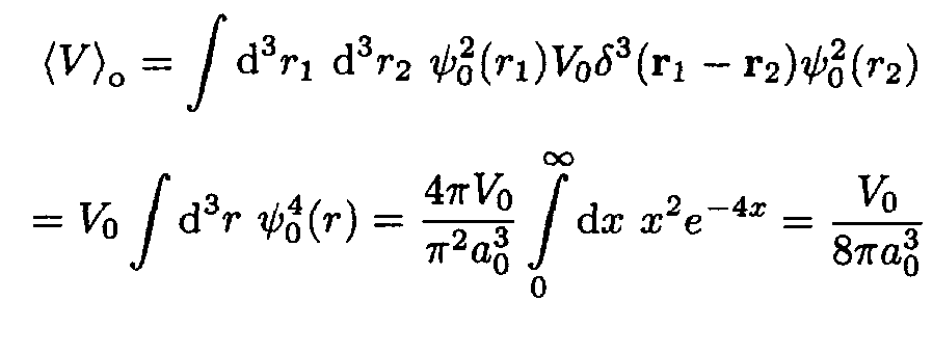
Interacting Electrons
 المؤلف:
Sidney B. Cahn, Gerald D. Mahan And Boris E. Nadgorny
المؤلف:
Sidney B. Cahn, Gerald D. Mahan And Boris E. Nadgorny
 المصدر:
A GUIDE TO PHYSICS PROBLEMS
المصدر:
A GUIDE TO PHYSICS PROBLEMS
 الجزء والصفحة:
part 2 , p 69
الجزء والصفحة:
part 2 , p 69
 18-8-2016
18-8-2016
 1789
1789
Interacting Electrons
Consider two electrons bound to a proton by Coulomb interaction. Neglect the Coulomb repulsion between the two electrons.
a) What are the ground state energy and wave function for this system?
b) Consider that a weak potential exists between the two electrons of the form
 (1)
(1)
where V0 is a constant and sj is the spin operator for electron j (neglect the spin–orbit interaction). Use first-order perturbation theory to estimate how this potential alters the ground state energy.
SOLUTION
a) The wave function for a single electron bound to a proton is that of the hydrogen atom, which is
 (1)
(1)
where a0 is the Bohr radius. When one can neglect the Coulomb repulsion between the two electrons, the ground state energy and eigenfunctions are
 (2)
(2)
 (3)
(3)
 (4)
(4)
The last factor in (3) is the spin-wave function for the singlet S = 0 in terms of up α and down spin states. Since the spin state has odd parity, the orbital state has even parity, and a simple product function ѱ(r1)ѱ(r2) is correct. The eigenvalue is twice the Rydberg energy ER.
b) The change in energy in first-order perturbation theory is δE = ⟨i|V|i⟩. The orbital part of the matrix element is
 (5)
(5)
where the final integration variable is x = r/a0.
Next we evaluate the spin part of the matrix element. The easiest way is to use the definition of the total spin S = s1 + s2 to derive
 (6)
(6)
 (7)
(7)
where for spin-1/2 particles, such as electrons, s1 . s1 = s(s + 1) = 3/4. Since the two spins are in an S = 0 state, the expectation value ⟨s1 . s1⟩ = -3/4. Combining this with the orbital contribution, we estimate the perturbed ground state energy  to be
to be
 (8)
(8)
 الاكثر قراءة في مواضيع اخرى
الاكثر قراءة في مواضيع اخرى
 اخر الاخبار
اخر الاخبار
اخبار العتبة العباسية المقدسة


